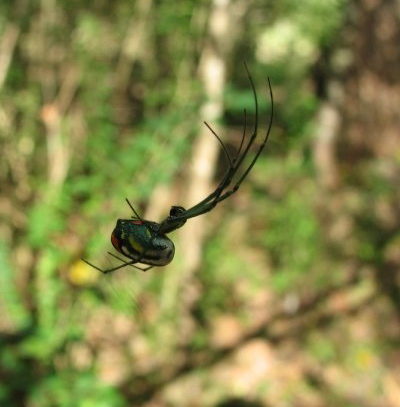
|
Orchard Orbweaver - Leucauge venusta
Size: 5mm
Web is circular with an open center and is often horizontal. The underside of this spider is green and yellow with orange spots, while the back has
silvery stripes. |
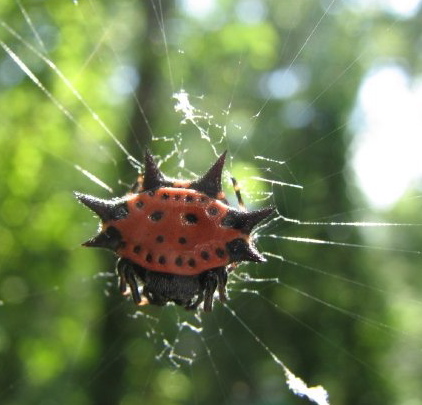
|
Spiny Crab-like Orbweaver - Gasteracantha cancriformis
Size: 9mm
This spider is wide, flat, crab shaped, and can be red, white, orange, or yellow, with dark spots that seem to form a "smiley face" or a
skull. Females are spotted by the 6 spines lining the outside of the body. The web features dotted white lines of sticky, doubled silk along the
outside. |
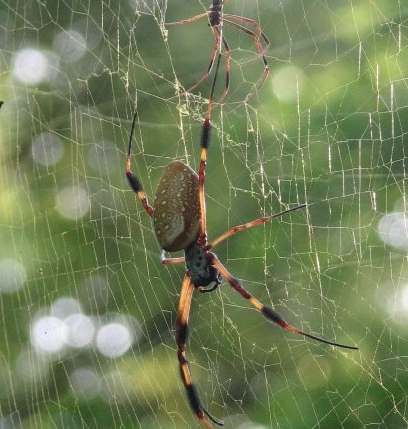
|
Golden Silk Spider - Nephila clavipes
Size: Female 23mm; male 6mm.
Commonly called "Banana spider". The golden webs can span distances of several yards and are strong enough to capture large prey
like cicadas. The body of this spider is an orange color; the legs feature tufts of black hair at the joints. The spider's head is white
with black markings and seems to resemble a skull. |
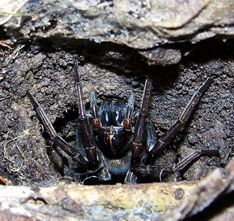
|
Giant Wolf Spider - Hogna carolinensis
Size: Female 23mm avg; male 19mm avg.
The largest of the wolf spiders, this spider usually builds a burrow in the ground. Females carry the egg sac underneath them until hatching
occurs. The female will then carry about 100 spiderlings on her back for up to 2 weeks. The wolf spider is often mistaken for the tarantula,
which does not occur in this area. |
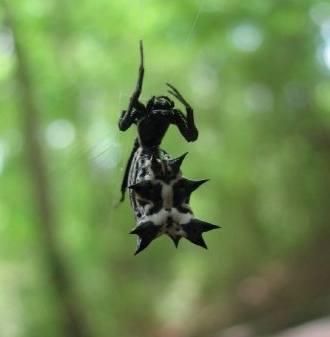
|
Kite Spider - Micrathena gracilis
Size: Female 8mm avg; male 4mm avg.
The spiny projections on this spider's abdomen make them hard to eat and helps to keep them hidden from predators. There are five pairs of
equally sized spines on the abdomen. Most common colors are black and white. Compare to the Arrow Spider. |
| |
Common House Spider - Achaearanea tepidariorum
Size: 5mm
The Common House Spider is the most commonly seen spider in North America. They can be found in and around houses, barns, sheds and other
structures. The web is irregular and usually found in corners. The spider's abdomen is bulbous and marbled. The Common House Spider is
often confused with the Widow Spiders. |
| |
Marbled Orbweaver - Araneus bicentarius
Size: Female 18mm avg; male 6mm.
These orbweavers have bulbous abdomens and vary in color. They usually hang head down in the center of the web with their legs tucked in.
The spider replaces its vertical circular web with a new web each night in total darkness using its excellent sense of touch. |
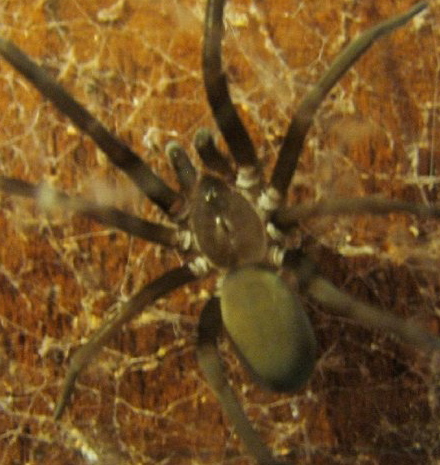
|
Southern House Spider - Kukulcania hibernalis
Size: Female 15mm avg; male 9mm avg.
This uniformly brown spider is often confused with Recluse spiders. The females live around eight years, but the males die after mating. The
Southern House Spider is in a group known as crevice weavers; their webs are tunnel-like and found in cracks. They use guidelines of silk to
feel vibrations of prey that gets near the web. |
| |
Barn Spider - Neoscona sp.
Size: 10mm avg
Compact spider with reddish legs; usually folded in. Triangle shaped abdomen of varying colors. Round, vertical web. The Barn spider can most
often be found in the center of the web. |
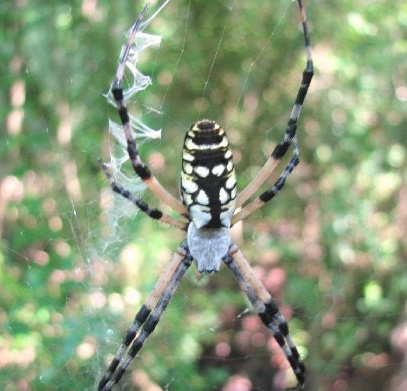
|
Black & Yellow Argiope - Argiope aurantia
Size: 25mm avg
Large, yellow, black and white spider. Argiopes usually sit in the center of their web. Web is characterized by the vertical zigzag white pattern
in the center which is used to stabilize the web under the weight of the spider and its prey. They can easily catch and eat prey twice their own
length. |
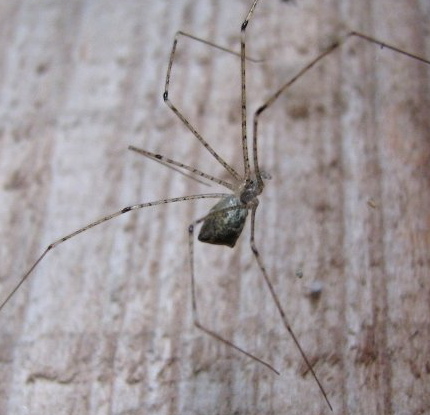
|
Cellar Spider - Pholcus phalangioides
Size: 7mm avg.
The long, spindly legs of this spider are often mistaken for "Daddy long legs". The abdomen is grey and pale yellow in color. Webs are
irregular shapes, and the spider can be found hanging upside down from the web. When disturbed the spider will vibrate the web so fast that it
looks blurry and can confuse predators. |
| |
Harvestman - Order: Opiliones
Size: 6mm
Harvestmen are commonly known as "Daddy long legs". Although they are not spiders they do belong to the family of arachnids. Harvestmen
do not have venom, lack fangs, and do not make webs. Their eight legs are used for walking, breathing, smelling, and catching prey. Harvestmen
can be found almost anywhere, alone or in groups. There are 200+ species in N. America. |
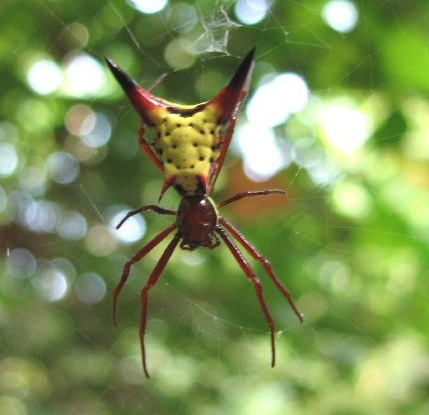
|
Arrow Spider - Micrathena sagittata
Size: Female 8mm; male 4mm.
The Arrow Spider has yellow, red and black colors on the abdomen along with two large, black spines and two pairs of smaller spines for protection
and disguise. The web is usually well hidden and near the ground. Sometimes the web has a vertical white zigzag pattern from the top to the center
for stabilization. |
| |
Green Lynx - Peucetia viridians
Size: 14mm avg.
The body of the Green Lynx is predominantly bright green with white and red markings; the legs are covered in black spines. These spiders inhabit
flowers, grass, and other foliage. They sit and wait for insects to visit the plant and then ambush and overpower their prey. |
| |
Crab Spider - Misumenops sp.
Size: 6mm avg.
Crab Spiders appear flattened and always hold their legs out to the sides with the front pairs longer than the others. Their ability to walk
sideways gave them the name "Crab" spider. They are ambush predators and can be found on flowers, foliage, and tree bark waiting for prey.
|
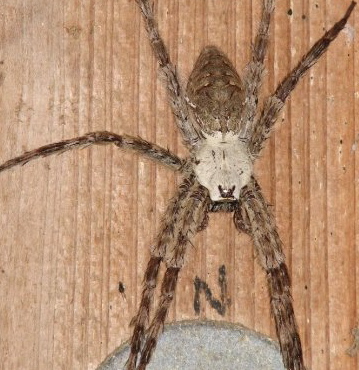
|
Fisher Spider - Dolomedes sp.
Size: Female 24mm avg; male 10mm avg.
Fisher Spiders are large, sprawling, and boldly marked. They are usually found around water and can be found on trees, buildings and boats. Some of
their adaptations include the ability to skate on the surface of water; they also dive underwater to catch prey and to escape enemies. |
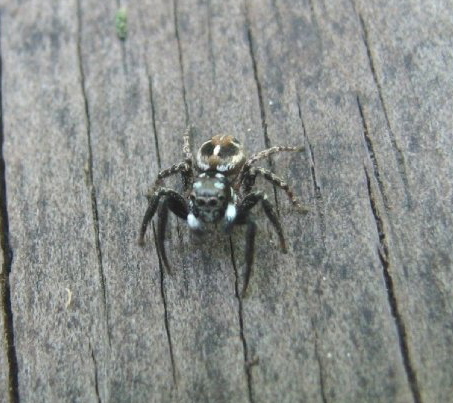
|
Jumping Spider - Corythalia canosa
Size: 5mm avg.
These spiders are brown and black with white dots on their head, and have white mouth parts that are constantly moving. Jumping Spiders have the
best vision of all spiders and can be seen stalking prey. They can jump several times their body length and often attach a strand of silk to
something before jumping so that it can be used as a safety rope so they can regain their position. |
| |
Trapdoor Spider - Ummidia sp.
Size: up to 25mm
Trapdoor spiders are close relatives of tarantulas. They are smaller with less hairy abdomens and shiny legs. Trapdoor spiders prey mostly on other
insects. The trapdoor spider is preyed on extensively by parasitic wasps. They build tunnels in disturbed areas, along insect walkways. The tunnel
is capped with a trapdoor. The most well-known is the *cork*-type door, which is very thick and fits the opening exactly. The other is the
*wafer*-type door, which is a sheet of silk and dirt. The doors are also equipped with silk hinges. The tunnel is used by the trapdoor spider as
shelter, as protection, as a nursery, and as a trapping device. The top of the door is camouflaged with bits of debris. When the spider is using
the trap to capture prey, it holds the lid shut and awaits the vibrations of passing prey. When prey hits the silk trip lines near the door the
spider throws open the hatch, grabs the prey and returns with it to the tunnel. The tunnel is also used as a nursery. The female remains with the
eggs, allowing the spiderlings to hatch and remain unharmed until they are eight months old. |
| |
Long-jawed Orbweaver - Tetragnatha sp.
Size: 9mm avg
Long-jawed Orb Weavers are named because of their large fangs, which are often longer than the spider's cephalothorax. All spiders in this
family have 8 eyes. Preferred habitat for long-jawed orb weavers is in vegetation near water. Like true orb weavers, long-jawed orb weavers build
webs that resemble a circle. At rest, these spiders lay along a twig or piece of grass and extend their legs forward and back to blend into their
habitat. |
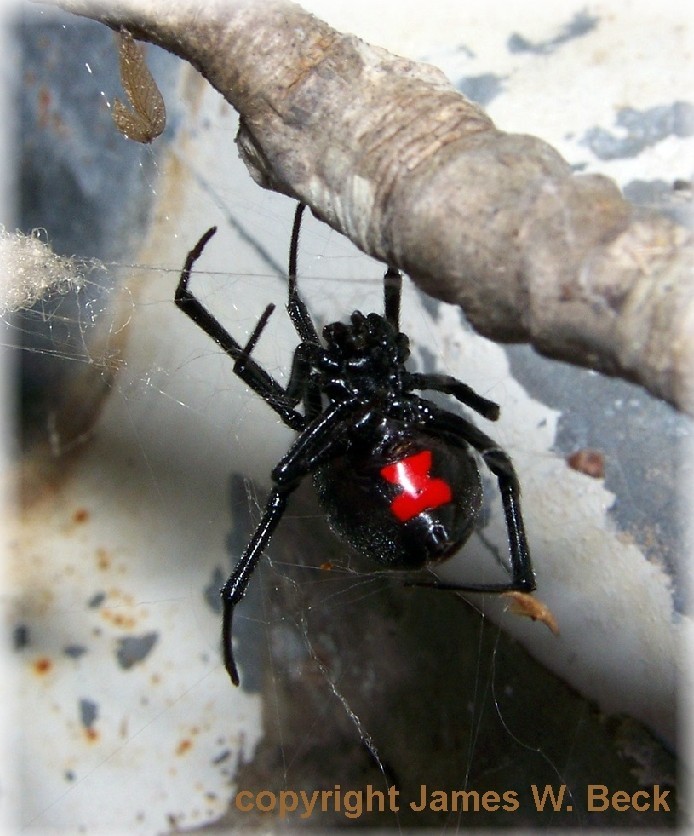
|
Southern Widow - Latrodectus mactans
Size: 9mm
There are three North American spider species of what people refer to as "black widows". Biologists recognize Southern, L. mactans;
Northern, L. various and Western, L. hesperus. The female widow can live over 3 years. The female's abdomen is black and rounded with a red
hourglass marking on the underside. The male is about half the size of the female and has an oval-shaped abdomen with white and red side markings.
Widows are commonly found beneath undisturbed piles of wood and tires, as well as in old wrack lines, inside portable toilets, around abandoned
buildings, and in crawl areas. Their diet consists of insects including crickets, and beetles as well as arthropods. Their web is a strong,
irregularly patterned cobweb. They are the largest members of the cobweb weaver family (Theridiidae). Contrary to popular belief, the male is
not always consumed after mating. Even though the venom of the black widow is 15 times as toxic as that of a rattlesnake, less than 1% of the
people bitten by a widow die. |
| |
Brown Widow - Latrodectus geometricus
Size: 11mm
Not native to the U.S. but is well established in many areas. Both genders of the brown widow have banded legs. The body of the female brown can
be any variety of brown shades, from light to dark. The hourglass of this species is usually some shade of orange. Like the male of other widow
species, the male of the brown widow is slender and smaller than the female. This species is widely distributed in tropical zones and has been
introduced along the Gulf Coast through commerce, shipping, etc. The brown widow can be found in buildings or piles of wood but unlike other widows,
the brown widow will make webs in areas that are regularly disturbed. All widows, when disturbed, at one point or another, will fall out of the web,
roll into a ball and play dead. The brown widow's venom is more toxic than other widow species, although less is injected. This spider's egg
sac has tiny spikes on the surface, while other widows' egg sacs are smooth. |